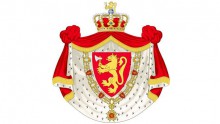Historical contacts between Ukraine and Norway date back to the end of the 1st millennium AD. The era of common history lasted for several centuries, from the foundation of Kyivan Rus’ onwards, and was expressed in the interlacing of mutual influences.
There are two main – Norman and alternative Soviet – theories of the origin of Kyivan Rus’ in historiography. The latter argues that Kyivan princes were of Slavic origin and the name Rus’ derives from local toponyms. The Norman theory, the most widespread now in the West, expounds the Scandinavia root of Ancient Rus’ princes, including the legendary ruler of Novgorod (after 862) Rurik (Riuryk). Accordingly, Western academics explain the origin of the name “Rus’” by the endonym of Scandinavian tribes.
Debates on the origin of Kyivan Rus’ (Scandinavian name – Gardarike) are still on. It is known for certain that the first Scandinavian rulers of Kyivan Rus’ were Askold and Dir, who moved from Novgorod to Kyiv and settled there. After this, a lot of Scandinavians (Varangians) arrived in Kyiv and Constantinople, where they served in a special unit of mercenaries. Other Vikings – merchants – used to stay in Kyiv for a long time, carrying on trade on the legendary way “from the Varangians to the Greeks,” i.e., from the Gulf of Finland to the Black Sea through the Dnieper.
In 975-1066, Norway and Kyivan Rus’ maintained particularly friendly relations. Many descendants of Norwegian kings and noblemen stayed at the Kyivan court for a long time, receiving military training and taking part in campaigns against Constantinople (Miklagard in Old Norse), from where they brought rich spoils.
For example, the famous King Olaf Tryggvason of Norway (968-1000) was brought up from his early childhood at the court of Volodymyr the Great in Kyiv. Legend has it that he spoke both the Old Norse and the Old Slavonic languages.
Interestingly, Sweden was trying at the time to enter into an alliance with Norway by way of royal intermarriage. Characteristic in this connection is the destiny of Yelyzaveta Yaroslavna’s mother Ingegerd (Princess Iryna after baptism). Before marrying her off to Prince Yaroslav the Wise, her father King Olof of Sweden had promised her hand to Norway’s King Saint Olaf (the Baptist of Norway, ruled in 1015-28), which made them implacable enemies. Some information suggests that St. Olaf stayed at Prince Yaroslav’s court when he was in exile from the Norwegian land (c. 1029) and, when coming back home, he left his son Magnus, the future King Magnus the Good of Norway (ruled in 1035-47) in Kyiv for education.
But the most legendary marriage in the 1,000-year-long history of Kyiv-Oslo relations was that of Harald Hardrada and Yelyzaveta (Elisiv in Scandinavian), the daughter of Yaroslav the Wise and Ingegerd. Harald stayed at Prince Yaroslav’s court for a long time together with his nephew Magnus. Norwegian sagas say that, after Yaroslav the Wise had denied Harald Yelyzaveta’s hand because this marriage would have been a misalliance, he went to serve in Constantinople from which he came back with the reputation of a great warrior and a lot of treasures. Presumably, it is Harald who wrote the ancient Scandinavian saga about Yaroslavna, where every stanza ends with this refrain: “…only the maiden with a Ruthenian braid despises me.” They got married in 1045, and approximately in a year’s time Harald, his wife, and a large armed retinue left for Norway.
When Magnus died in 1047, Harald Hardrada became the king of Norway and founded in the same year a new capital of Norway, Oslo, which was the royal residence from then on. Harald was killed in the battle for England in 1066. It is known that Yelyzaveta was waiting for his triumphal comeback in the Orkney Islands.
Harald’s death signaled the end of the period of Norway’s victorious history as well as of an independent foreign policy. Later, as a result of the Kalmar Union (1397), Norway came under the power of the Danish king and was ruled by the king of Sweden from 1814 until 1905. Norway gained independence in 1905.
Norway recognized Ukraine’s independence on December 24, 1991. Diplomatic relations between Ukraine and the Kingdom of Norway were established on February 5, 1992. The Norwegian Embassy in Ukraine was opened in 1992. A full-fledged Embassy of Ukraine in Norway began to function in October 2004.







